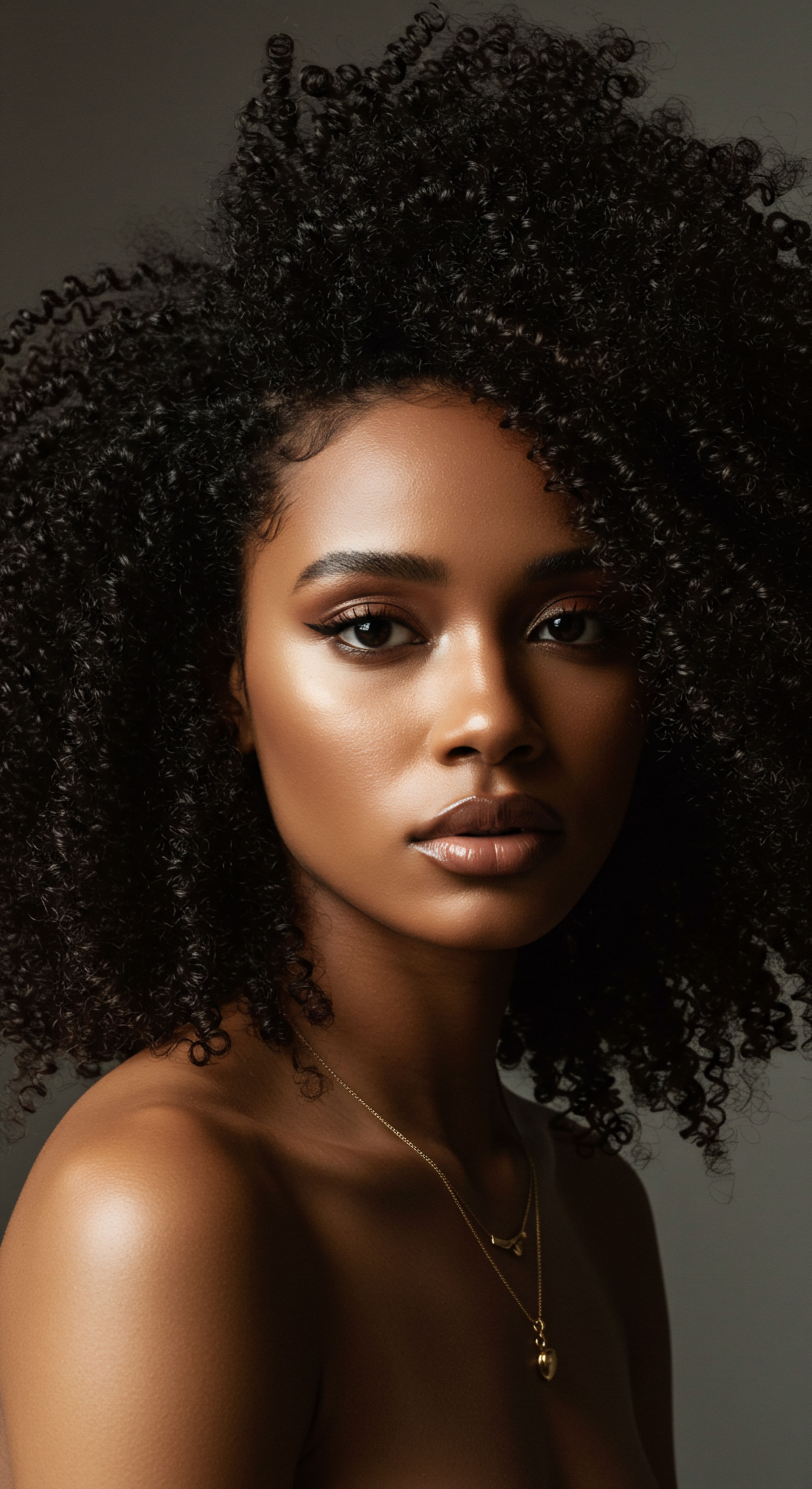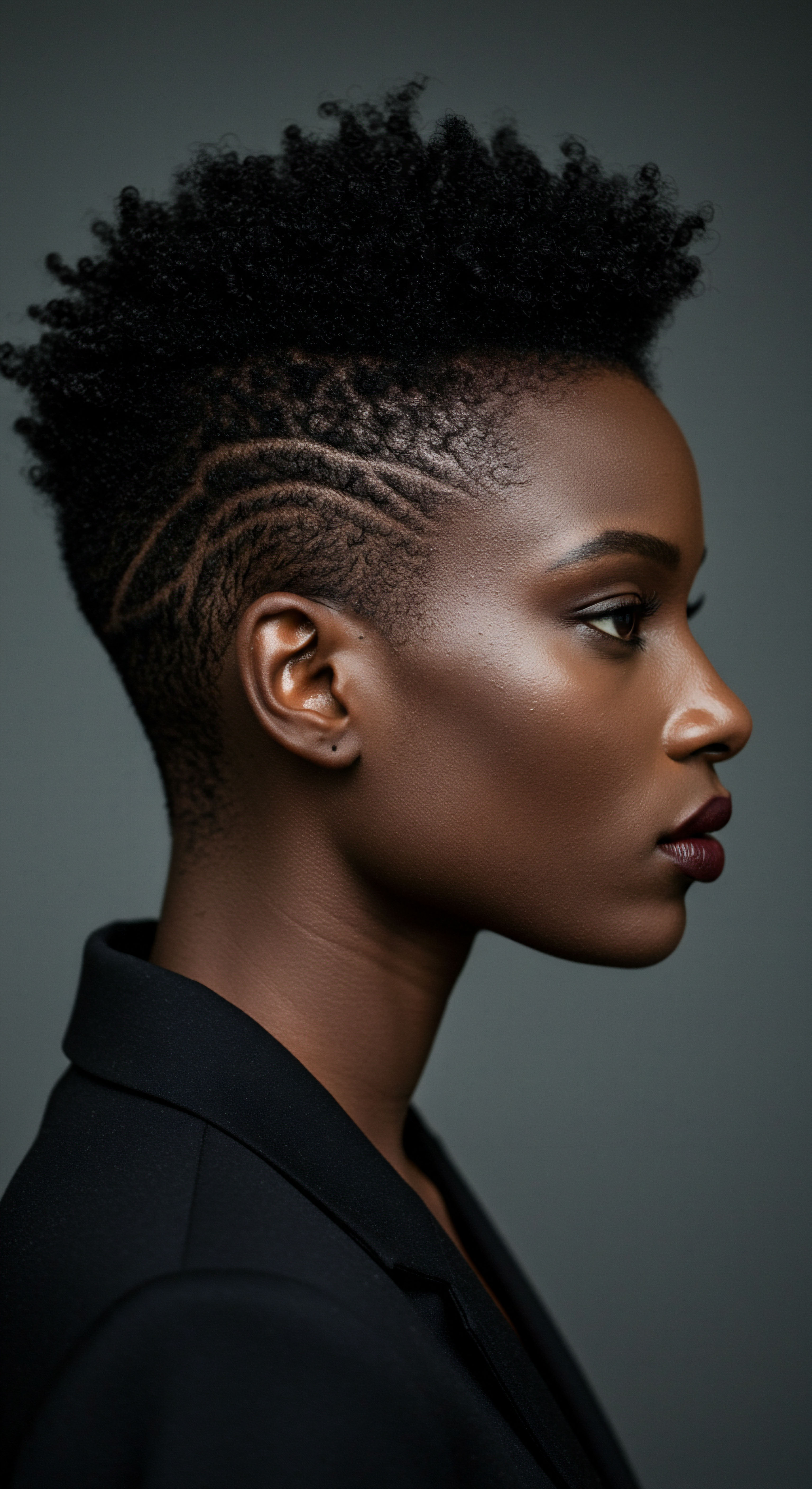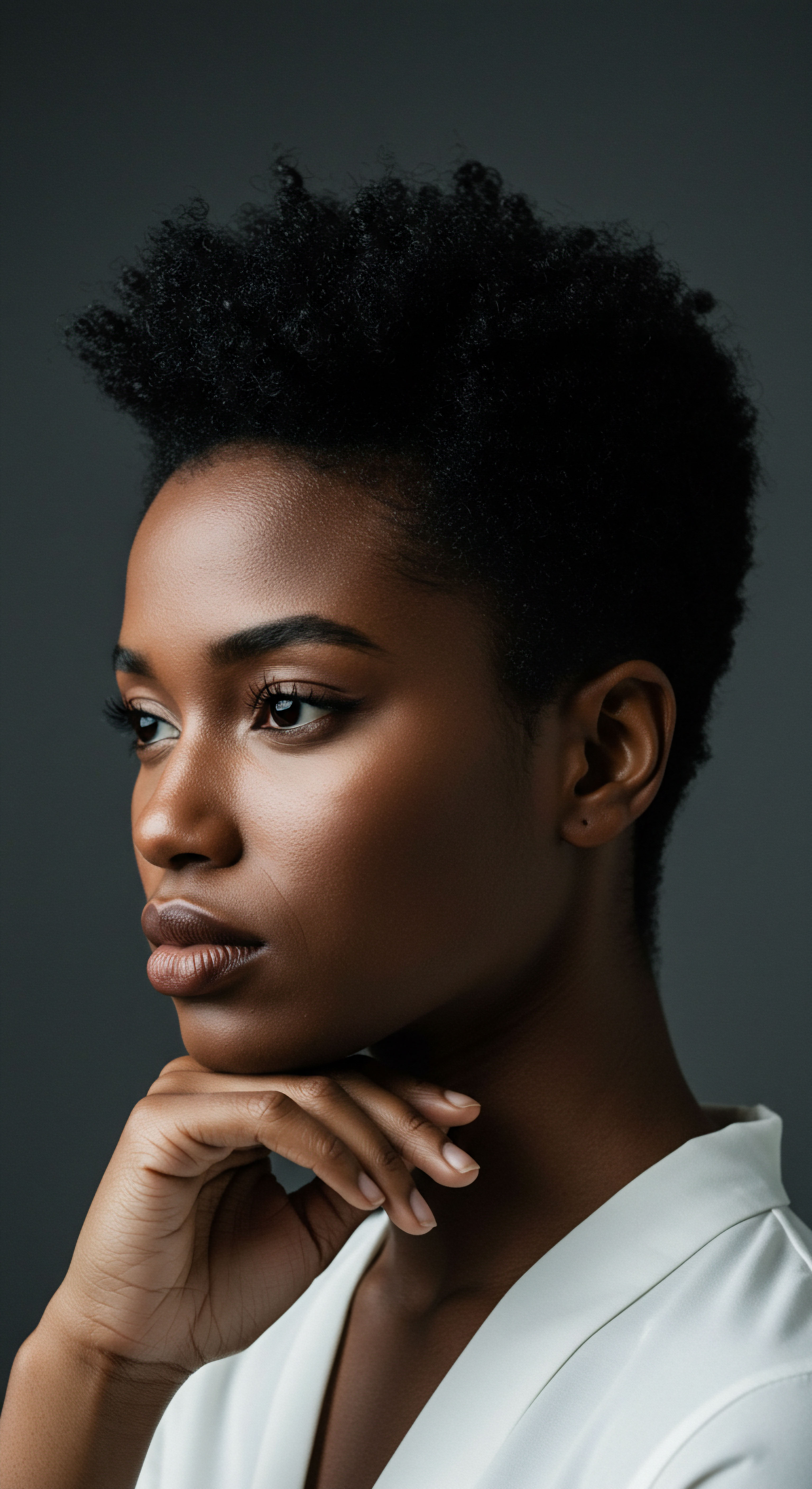
Roots
The whisper of water, the gentle scent of green things, and the quiet ritual of cleansing our strands. It is a moment many of us hold dear, a pause in the daily rhythm. Yet, beneath the surface of this simple act, a bustling, unseen world exists ❉ the scalp’s delicate ecosystem. This intricate balance, a living landscape upon our very heads, responds to every touch, every ingredient.
For those with textured hair, this connection runs even deeper, tied to generations of care and ingenuity. Our hair, a crowning glory, begins its journey from this vital terrain. Understanding what plant compounds in our cleansers influence this hidden garden becomes not merely a matter of product choice, but a recognition of a profound, biological conversation.

The Scalp’s Living Surface
The scalp is more than just skin; it is a complex biological environment. It boasts a unique microbiome, a community of microorganisms, including bacteria and fungi, that coexist. This microbial community, along with sebum production, pH levels, and the integrity of the skin barrier, forms a finely tuned system. When this system is in balance, the scalp feels comfortable, and hair grows well.
Disruptions, however, can lead to discomfort, flaking, or other challenges. Cleansers, the very products we use to purify this area, carry the potential to either support or disturb this natural equilibrium.
The scalp’s hidden garden, a complex ecosystem of microbes, sebum, and skin barrier function, profoundly influences hair health.

Plant Compounds as Gentle Purifiers
Across the globe, and through centuries, plant-based ingredients have served as foundational elements in hair care. Long before synthetic surfactants, people relied on nature’s own cleansing agents. These botanical wonders offer a spectrum of benefits beyond mere cleaning, often contributing to the overall health of the scalp.
- Saponins ❉ Found in plants like Shikakai (Acacia concinna) and Reetha (Sapindus mukorossi), these natural compounds create a gentle lather. They effectively remove dirt and excess oil without stripping the scalp of its essential moisture. Shikakai, for instance, has been traditionally used as a hair cleanser and for dandruff control.
- Antimicrobials ❉ Certain plant extracts, such as those from Neem (Azadirachta indica), Tea Tree (Melaleuca alternifolia), and Thyme, possess properties that help manage microbial populations on the scalp. These can be particularly helpful in addressing concerns like dandruff, which is often linked to an overgrowth of yeast such as Malassezia. Neem extracts, specifically, have shown promising antifungal activity against Malassezia furfur.
- Soothing Agents ❉ Plants like Aloe Vera and Chamomile are well-regarded for their calming qualities. Their compounds can help reduce irritation and redness on a sensitive scalp, offering a sense of relief and comfort.

The Balance of Cleansing
The quest for a truly clean scalp can sometimes lead to overly harsh cleansing practices. Traditional shampoos, often relying on strong synthetic surfactants, can strip away natural oils, disrupting the scalp’s protective barrier and altering its pH. Plant compounds, conversely, frequently offer a gentler approach.
They work to cleanse while helping to maintain the scalp’s natural pH and oil balance. This thoughtful cleansing respects the scalp’s inherent processes, rather than overwhelming them.
| Plant Source Shikakai (Acacia concinna) |
| Primary Compounds Saponins |
| Scalp Influence Gentle cleansing, dandruff management |
| Plant Source Neem (Azadirachta indica) |
| Primary Compounds Flavonoids, Polyphenols |
| Scalp Influence Antimicrobial, antioxidant, anti-dandruff |
| Plant Source Aloe Vera (Aloe barbadensis miller) |
| Primary Compounds Polysaccharides, Glycoproteins |
| Scalp Influence Soothing, hydrating, anti-irritation |
| Plant Source Tea Tree Oil (Melaleuca alternifolia) |
| Primary Compounds Terpenes |
| Scalp Influence Antifungal, purifying, tingling sensation |
| Plant Source Rosemary (Rosmarinus officinalis) |
| Primary Compounds Phenolic compounds, Rosmarinic acid |
| Scalp Influence Antioxidant, anti-inflammatory, scalp stimulation |
| Plant Source These botanical ingredients offer a range of benefits for maintaining scalp health. |

Ritual
The rhythmic motion of fingertips against the scalp, the cascade of water, the subtle aroma of botanical extracts – these are the components of a cleansing ritual. It is in these moments that the practical wisdom of plant compounds comes alive, translating scientific properties into tangible sensations and lasting effects. For textured hair, where delicate coils and curls often require specific care, the choice of cleanser and the manner of its application are particularly significant. This section guides us through the purposeful practices that bring plant compounds into effective conversation with our scalp.

How Do Cleansers with Plant Compounds Work on the Scalp?
Plant compounds in cleansers work in concert to purify and protect. Some, like saponins from soapberry, act as natural surfactants, creating a gentle foam that lifts away sebum, product buildup, and environmental pollutants. This is achieved without the harsh stripping often associated with some synthetic detergents, preserving the scalp’s natural lipid barrier.
Other plant compounds, such as those with anti-inflammatory properties, help to calm any irritation that might be present, making the cleansing experience a soothing one. The pH of these plant-based formulations is also a consideration; many are designed to align with the scalp’s slightly acidic pH, supporting its natural protective functions.
Plant-based cleansers purify gently, supporting the scalp’s natural balance rather than stripping it away.

Choosing Cleansers for Textured Hair
Textured hair, with its unique structure, often experiences dryness more readily than straighter hair types. This makes the selection of a cleanser that respects the scalp’s moisture levels paramount. Plant compounds that offer hydration and soothing properties become especially valuable.
- Hydrating Botanicals ❉ Ingredients like aloe vera, known for its hydrating polysaccharides, or plant-derived glycerin, can help attract and hold moisture on the scalp, preventing dryness during the cleansing process.
- Non-Stripping Surfactants ❉ Cleansers featuring natural saponins or mild, coconut-derived surfactants help ensure that essential oils are not excessively removed. This preserves the scalp’s natural lubrication, which is vital for the health of textured strands.
- Anti-Inflammatory Agents ❉ Scalp sensitivity can be a concern for many, particularly with styling practices common for textured hair. Plant extracts such as chamomile or calendula can help reduce redness and discomfort, ensuring a more comfortable scalp environment.

The Role of Cleansing Frequency and Technique
The frequency of cleansing, along with the technique employed, significantly impacts how plant compounds interact with the scalp ecosystem. For textured hair, infrequent washing, while common, can lead to product buildup and an imbalance in the scalp microbiome. Regular, yet gentle, cleansing is often recommended.
A study on scalp microbiome composition noted that a hygienic scalp surface is important for skin to do well. This suggests that consistent, mild cleansing helps to maintain a healthy scalp environment, allowing the beneficial effects of plant compounds to truly take hold. When applying cleansers, a gentle massage helps to stimulate blood flow and evenly distribute the plant compounds, allowing them to work effectively without causing irritation.
| Aspect of Ritual Gentle Application |
| Influence on Scalp Ecosystem Reduces physical irritation, aids absorption |
| Plant Compound Benefit Allows soothing compounds (e.g. Aloe) to calm skin |
| Aspect of Ritual Appropriate Frequency |
| Influence on Scalp Ecosystem Prevents buildup, maintains microbial balance |
| Plant Compound Benefit Supports antimicrobial botanicals (e.g. Neem) in managing scalp flora |
| Aspect of Ritual Thorough Rinsing |
| Influence on Scalp Ecosystem Removes residues, prevents pore blockage |
| Plant Compound Benefit Ensures cleansing saponins do their work without leaving residue |
| Aspect of Ritual Thoughtful cleansing practices amplify the positive effects of plant compounds on the scalp. |

Relay
Beyond the surface of a simple cleanse, a deeper conversation unfolds between plant compounds and the living landscape of our scalp. This dialogue is not always straightforward; it is a complex interplay of biochemical reactions, microbial shifts, and ancestral wisdom. For textured hair, this conversation holds particular significance, as its unique structure and care practices often reveal the subtle, yet profound, effects of these botanical allies. We consider here the sophisticated ways plant compounds relay their messages to the scalp’s ecosystem, moving beyond basic cleaning to influence its very cellular functions and microbial populations.

Can Plant Compounds Rebalance the Scalp Microbiome?
The scalp microbiome, a bustling city of microorganisms, plays a central role in scalp health. When this delicate balance is disturbed, issues like dandruff, irritation, and even hair thinning can arise. Recent studies point to the potential of plant compounds to help restore this equilibrium.
For instance, research on soapberry (Sapindus mukorossi) pericarp fermentation filtrate indicated its ability to influence the microbial diversity and composition of the human scalp, enriching pathways associated with a healthy scalp and decreasing fungal pathogenesis pathways. This suggests that beyond simple cleansing, certain plant extracts can act as prebiotics or possess direct antimicrobial actions that selectively support beneficial microbes while deterring problematic ones.
One fascinating aspect of this microbial conversation involves the ratio of certain bacteria. In dandruff conditions, for example, an imbalance is often observed, with a higher proportion of Malassezia restricta and Staphylococcus capitis, and a lower abundance of Cutibacterium acnes. Plant compounds, such as those found in Neem and Tea Tree oil, are known for their antifungal and antibacterial qualities, offering a means to manage these populations without completely eradicating them, thereby working towards a healthier microbial state. This selective influence is a far cry from harsh, broad-spectrum antimicrobials that can disrupt the entire ecosystem.

How Do Plant Bioactives Influence Scalp Barrier Function and Cellular Health?
The scalp’s barrier function, its outermost protective layer, shields against environmental aggressors and prevents excessive moisture loss. This barrier is critical for maintaining overall scalp health, especially for textured hair which can be prone to dryness. Plant compounds offer a rich array of bioactives that can support this barrier and influence cellular processes.
Polyphenols and flavonoids, abundant in many plant extracts like green tea or neem, possess significant antioxidant properties. These compounds combat oxidative stress, which can damage scalp cells and contribute to aging of hair follicles. A double-blind, placebo-controlled study on a specific botanical extract blend showed improvements in scalp moisturization and a decrease in transepidermal water loss (TEWL), a measure of barrier integrity, even in urban outdoor workers exposed to pollution. This indicates that certain plant compounds can actively fortify the scalp’s defenses.
Furthermore, some plant compounds can directly influence the physiological processes of the scalp. For example, Timosaponin B-II, a compound present in Anemarrhena asphodeloides, has been studied for its benefits in improving scalp hydration, reducing dandruff, and potentially preventing hair loss. This saponin appears to influence the stratum corneum barrier homeostasis and integrity, suggesting a deeper impact on the scalp’s structural health.
Plant compounds do more than clean; they engage in a sophisticated biochemical dialogue with the scalp’s cells and resident microbes.
The use of plant-derived ingredients in hair care is not a new concept; it is deeply rooted in traditional practices across various cultures. African Black Soap, for instance, made from the dry skin of local vegetation like cocoa pods and plantain leaves, is packed with antioxidants and minerals. It cleanses the scalp without stripping natural oils, offering healing nutrients and helping follicle cells grow hair. This historical knowledge provides a rich context for understanding the sophisticated actions of plant compounds.
A point of discussion arises when considering the modern scientific perspective versus long-standing traditional uses of plant-based cleansers, particularly within textured hair communities. For generations, certain raw oils, butters, and clays have been applied directly to hair and scalp for maintenance and length retention, often with excellent results. Yet, some contemporary natural hair stylists advocate against the direct application of raw oils and butters, citing potential for product buildup or hindering water absorption. This apparent contradiction highlights the need for a nuanced understanding ❉ while modern science can explain specific mechanisms, traditional practices often represent complex, synergistic applications of plant materials developed over time, whose full benefits may not be reducible to isolated compounds.
The Himba Tribe of Namibia, for example, coats their hair in red clay, a practice that seemingly defies modern warnings against clay buildup, yet their hair remains robust. This suggests that the interplay of ingredients, application methods, and environmental factors in traditional contexts creates a unique, balanced outcome.
| Compound Type Saponins |
| Mechanism of Action Natural surfactants, emulsify oils |
| Ecosystem Impact Gentle cleansing, sebum regulation, maintain barrier |
| Compound Type Polyphenols/Flavonoids |
| Mechanism of Action Antioxidant, anti-inflammatory |
| Ecosystem Impact Reduce oxidative stress, calm irritation, support cellular health |
| Compound Type Terpenes |
| Mechanism of Action Antimicrobial, antiseptic |
| Ecosystem Impact Manage microbial populations (e.g. Malassezia), purify scalp |
| Compound Type Polysaccharides |
| Mechanism of Action Humectant, film-forming |
| Ecosystem Impact Hydrate scalp, support barrier function |
| Compound Type Plant compounds offer diverse actions that contribute to a balanced and healthy scalp. |

Reflection
The journey through the intricate world of plant compounds in cleansers, and their dance with the scalp’s delicate ecosystem, reveals a profound truth ❉ the simplest acts of care hold layers of scientific wonder and cultural wisdom. Our exploration shows us that a cleanser is not merely a tool for removal, but a conduit for communication between nature’s bounty and our own biological landscape. As we continue to seek balance and vitality for our textured strands, perhaps the most meaningful step is to listen more closely to what our scalp is telling us, and to respond with the gentle, informed hand that honors both tradition and scientific discovery.

References
- Learn Canyon. “Why Botanical Extracts Are Essential For Scalp Care.” 2025.
- Singh, S. “Natural alternatives from your garden for hair care ❉ Revisiting the benefits of tropical herbs.” Journal of Pharmacy & Bioresources, 2025.
- Hims. “Best Scalp Treatments.” 2025.
- Natural Colour Works. “A Guide To Plant Based Hair Health.” 2023.
- Africa Imports. “Traditional African Secrets For Long And Healthy Hair.”
- Boots. “3 Afro Hair & Scalp Conditions and How to Treat Them.” 2022.
- CN104274357A. “Scalp care composition containing plant tincture and preparation method.” Google Patents.
- Xiao, L. et al. “A Timosaponin B‐II containing scalp care solution for improvement of scalp hydration, dandruff reduction and hair loss prevent.” Journal of Cosmetic Dermatology.
- Yadav, S. et al. “Development and Characterization of a Novel Polyherbal Dry Hair Shampoo Powder ❉ Research Article.” Journal of Pharma Insights and Research, 2025.
- Jagadeesh, I. “The Role of Microbiome, Sebum and Natural Remedies in Dandruff Management.” International Journal of Pharmaceutical Sciences, 2025.
- Ma, X. et al. “Investigation of the fermentation filtrate from soapberry (Sapindus mukorossi Gaertn.) pericarp on improving the microbial diversity and composition of the human scalp.” PubMed Central, 2024.
- Sharma, R. et al. “Shikakai.” Research Journal of Topical and Cosmetic Sciences.
- Pourkhorshidi, M. et al. “Preparation of Strong Antidandruff Shampoo Using Medicinal Plant Extracts ❉ A Clinical Trial and Chronic Dandruff Treatment.” Brieflands.
- Piccardi, N. et al. “Skin and Scalp Health Benefits of a Specific Botanical Extract Blend ❉ Results from a Double-Blind Placebo-Controlled Study in Urban Outdoor Workers.” MDPI.
- Reddit. “No raw oils and butters vs. Traditional African hair care? ❉ r/Naturalhair.” 2021.
- Schäfer, M. et al. “Scalp Microbiome and Dandruff—Exploring Novel Biobased Esters.” MDPI.